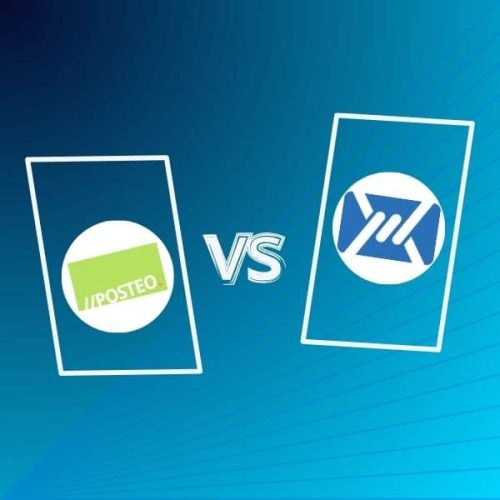Choosing a secure email provider has become increasingly important as privacy concerns continue to grow. Users are seeking platforms that offer robust security, transparency, and control over their data. In this article, we provide a full comparison of Posteo vs Mailfence, looking at pricing, features, encryption, interoperability, and more. Let’s explore.
Want to compare more providers? See how Mailfence stacks up against 9 other private email services in our complete guide of the 10 best secure email providers, including detailed security scores and pricing.
Posteo vs Mailfence: Overview
Posteo, founded in 2009 in Germany, is a privacy-focused email provider known for its sustainability approach and minimalistic design. It offers email, calendar, and contacts with optional encryption using external tools like Mailvelope. While Posteo supports open standards and strong transport security, users must manage end-to-end encryption manually, which may not suit everyone.
Mailfence is managed by ContactOffice, a Belgian company started in 1999. They provide a complete secure suite that includes email, calendar, contacts, online storage, polling, and more. It features built-in OpenPGP encryption, digital signatures, and key management, eliminating the need for plugins. Operating under strict Belgian privacy laws, Mailfence also publishes regular transparency reports and a warrant canary.
Posteo vs Mailfence: Pricing Comparison
Posteo uses a very simple pricing model, charging €1 per month. There is no free plan, and no premium. But for just 1€, you get all the features offered by Posteo. However, if you do need more storage, you can add it incrementally:
| Price | |
|---|---|
| Additional storage | 0.25 EUR per GB per month |
| Additional alias addresses | 0.10 EUR per month (two are included) |
| Additional calendars | 0.10 EUR per month (three are included) |
| Optional S/MIME certificate | 3.65 EUR (1-year validity) |
Although very flexible, costs can quickly add up. For example, if you need 20GB of email storage and 10 email aliases, you’ll need to pay:
- 18 * 0.25€ (2GB are already included in the base plan) = 4.5€/month
- 8 * 0.10€ (2 aliases already included) = 0.80€
This comes to a total of 1€ (base subscription) + 4.5€ + 0.80€ = 6.30€/month
On the other hand, Mailfence provides a more flexible range of plans.
There is a free tier with basic functionality, followed by several paid tiers that scale up in features and storage. The Base plan starts at €2.50 per month, with higher tiers like Entry, Pro, and Ultra offering additional features and storage space:
| Mailfence | Price |
|---|---|
| Free | 0 EUR / month |
| Base | 2.5 EUR / month |
| Entry | 3.5 EUR / month |
| Pro | 9.5 EUR / month |
| Ultra | 29 EUR / month |
This tiered model allows users to choose a plan that fits their usage level while gaining access to integrated security and productivity tools.
Posteo vs Mailfence: Feature Comparison
Email and Encryption
Posteo supports strong transport encryption, including TLS with Perfect Forward Secrecy and DANE. Emails can be encrypted using PGP, but this requires manual setup through a browser extension like Mailvelope. End-to-end encryption therefore depends on the user’s technical ability to manage keys externally.
Mailfence takes a more integrated approach to security.
It offers native end-to-end encryption with full OpenPGP support, built-in key management, and the ability to digitally sign and verify messages. Users can generate, import, and manage encryption keys without leaving the platform, making secure communication more accessible.
Both providers support open protocols such as POP3, IMAP and SMTP, but Mailfence goes one step further when it comes to encryption.
Collaboration Tools
Posteo offers basic tools such as calendar and contacts. However, it is not designed for collaboration. It lacks team-oriented features. There is no support for shared inboxes or any “group” features. You can “subscribe” to someone else’s calendar, but that is a “read-only” access.
Mailfence includes a full suite of collaboration features, such as shared calendars, group contacts, shared storage, and more. These tools are designed to facilitate teamwork and real-time coordination, making Mailfence suitable for professionals and organizations. The interface is unified across all services, including a dedicated mobile app that brings secure collaboration to any device.
For users and teams who need more than just email, Mailfence delivers a broader and more useful toolkit.
Mailfence — Your secure Productivity Suite
Reclaim your Privacy with
- Messages
- Calendars
- Documents
- Groups
Calendar comparison
| Feature | Mailfence | Posteo |
|---|---|---|
| Group Calendar | ✅ | ❌ |
| CalDAV support | ✅ | ✅ |
| iTIP/ iMIP support | ✅ | ✅ |
| Mobile Sync support | ✅ | ✅ |
| Obtain Calendar by SMS | ✅ | ❌ |
| Polls (Doodle-like) | ✅ | ❌ |
| Standalone mobile app | ✅ | ❌ |
| Default notifications per calendar | ❌ | ✅ |
Contacts comparison
| Feature | Mailfence | Posteo |
|---|---|---|
| Group Contacts | ✅ | ❌ |
| CardDAV Synchronisation | ✅ | ✅ |
| Tags | ✅ | ❌ |
| Comments | ✅ | ❌ |
Interoperability
A key difference between Mailfence and Posteo lies in how each service approaches interoperability with standard internet protocols.
Mailfence is committed to open standards and user freedom. It natively supports:
- IMAP and POP: Mailfence works seamlessly with any standard email client, including Outlook, Thunderbird, and Apple Mail. No additional tools are required.
- CalDAV and CardDAV: Synchronize calendars and contacts directly with third-party applications such as Thunderbird, Evolution, Outlook, or Apple’s ecosystem.
- WebDAV: Open, edit, and manage documents stored in Mailfence’s cloud without downloading them first. This is ideal for privacy-conscious users who value efficiency.
This level of compatibility makes Mailfence an excellent choice for individuals and organizations seeking privacy while maintaining integration with their existing tools or workflows.
Posteo, in contrast, imposes certain limitations:
- While Posteo does support IMAP, POP, CalDAV, and CardDAV, it does not offer end-to-end encryption for emails through those standard protocols.
- For encryption, users must configure PGP manually on their devices using third-party tools such as Thunderbird with Enigmail or Mailvelope.
- Posteo does not support WebDAV as it does not support online file storage.
Jurisdiction and Privacy Regulations
Posteo operates under German jurisdiction, which is known for its strong privacy protections. The service is transparent about its infrastructure and logging policies, and it avoids advertising or third-party tracking.
Mailfence is based in Belgium and also benefits from EU privacy laws. Mailfence supports this with transparency reports and a warrant canary to inform users about government data requests. For those particularly concerned about state-level surveillance or legal overreach, Mailfence provides strong visibility and assurance.
Posteo vs Mailfence: Summary
Posteo is ideal for users who want a low-cost, privacy-respecting email service with a simple setup and minimal environmental impact. It works well for individuals who are comfortable managing their own encryption and who do not need shared tools or advanced features.
Mailfence, on the other hand, is better suited for users who want a complete secure suite with built-in encryption and collaborative tools. It provides a more seamless experience for encrypted communication and is a strong choice for professionals, teams, or privacy-focused users who prefer a comprehensive platform without extra setup.
Ready to step up your online privacy? Create your Mailfence account today — for free.



